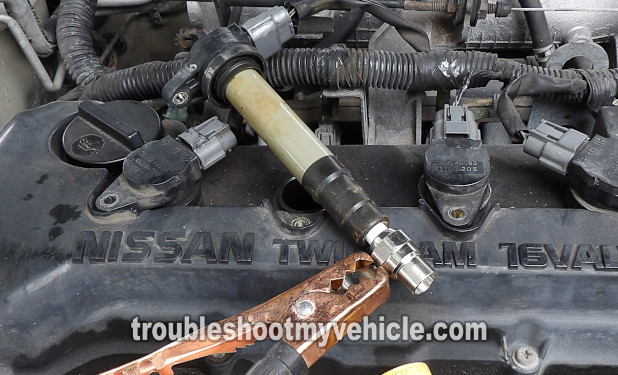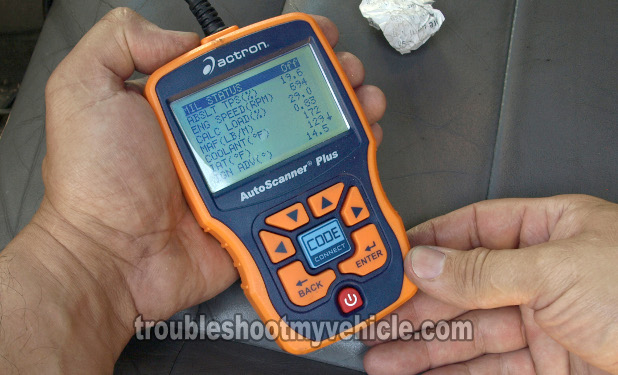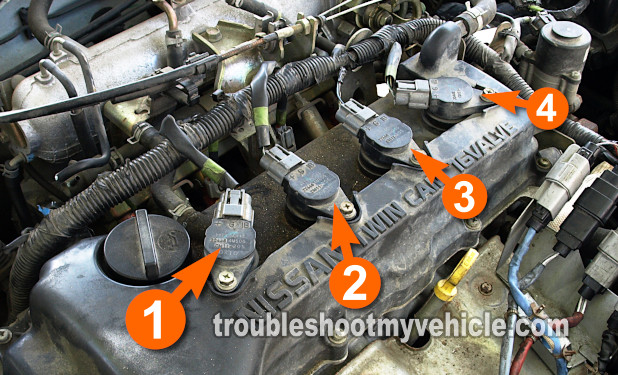TEST 1: Checking For Misfire Codes
The first thing you need to do to find the defective ignition coil is find the 'dead' cylinder first. To do this, simply use a scan tool to read the diagnostic trouble codes stored on your Nissan Sentra's computer.
If you don't have a scan tool, you can find the 'dead' cylinders by performing a cylinder balance test. For more information, see: TEST 4: How to Do A Cylinder Balance Test.
Let's get started:
- 1
Connect your scan tool or trouble code reader to the DLC connector.
- 2
Turn the key to the ON position.
- 3
Enter the "Read Codes" function of your scan tool or trouble code reader.
- 4
Retrieve any trouble codes stored in the computer's memory.
Let's interpret your test result:
CASE 1: You found one or more misfire trouble codes. The next step is to identify the misfire trouble code with the correct engine cylinder using photo 2 of 2 in the image viewer above.
- P0301: Cylinder #1 Misfire.
- P0302: Cylinder #2 Misfire.
- P0303: Cylinder #3 Misfire.
- P0304: Cylinder #4 Misfire.
Once you have identified the misfiring cylinder, the next step is to check if the ignition coil is firing a spark when you crank the engine. For this test, go to: TEST 2: Check The Ignition Coil For Spark.
CASE 2: You have a P0300 Misfire Code. This means that the source of the misfire is affecting all engine cylinders and not just one.
This code, (P0300) usually rules out a bad ignition coil or fuel injector as the culprit of the misfire issue. Although this is beyond the scope of this tutorial, I have a few suggestions for you, namely:
- Check to see if one or more engine cylinders have low engine compression.
- Check for vacuum leaks.
CASE 3: You DO NOT have any misfire codes. This usually means that the rough idle your Nissan is experiencing isn't caused by a bad ignition coil.
Now, the keyword here is 'usually' because your Nissan might have a bad ignition coil. I suggest you do a cylinder balance test: TEST 4: How To Do A Cylinder Balance Test.
Also, and preferably after the cylinder balance test, you need to do a thorough visual inspection of the spark plugs and ignition coils to see if:
- Spark plugs are:
- Soaked in oil (leaking valve cover gasket).
- Soaked in water (from power washing the engine).
- Cracked or broken.
- Center electrode's gap is filled/covered with carbon (from the cylinder burning Oil).
- COP coils are:
- Soaked in engine oil (leaking valve cover gasket).
- Soaked in water (from power washing the engine).
- Cracked or broken.
If none of the above components show any signs of damage or are soaked with engine oil, I would suggest an engine compression test:
TEST 2: Check The Ignition Coil For Spark

Once the misfiring cylinder has been identified (either by a diagnostic trouble code check or a cylinder balance test), the next step is to use an ignition spark tester to check whether or not the ignition coil is firing a spark.
IMPORTANT: You must test for spark with the engine cranking. Be careful, stay alert, and use common sense.
OK, to get this pie baked, this is what you need to do:
- 1
Remove the ignition coil from its place on the valve cover.
NOTE: If you had to disconnect the ignition coil to remove it, reconnect it now, since the ignition coil must be connected to its electrical connector for this test to work. - 2
Connect an HEI spark tester to the ignition coil. See the photo above.
NOTE: You can use any type of spark tester. The only reason I use and recommend the HEI spark tester is because this spark tester is accurate (and you don't have to worry about interpreting the color of the spark). - 3
Ground the HEI spark tester directly on the battery negative (-) terminal with a battery jump start cable.
- 4
When everything is set up, have a helper crank the engine while you observe the spark tester.
- 5
The spark tester will do one of two things: Spark or Not Spark.
- 6
Repeat this test once more to make sure of your test result.
- 7
Repeat the test steps on any other ignition coil you need to test.
Let's see what your test results mean:
CASE 1: The COP ignition coil sparked. This is the correct and expected test result and tells you that the ignition coil is OK.
If this cylinder is the one that the trouble code is identifying as misfiring, I suggest you run the following tests:
- Check for engine oil dripping from the valve cover gasket onto the spark plug and ignition coil boot.
- Check the spark plug for traces of carbon tracks on its porcelain insulator.
- Perform an engine compression test to see if this cylinder has low engine compression.
CASE 2: The ignition coil DID NOT spark. This test result usually means that the ignition coil is bad, but there's still something you need to do (to make sure the ignition coil is really bad).
The next step is to simply swap that ignition coil (that didn't spark) for another and then check both coils for spark. For this test and a better explanation go to: TEST 3: Swapping The Ignition Coil.



